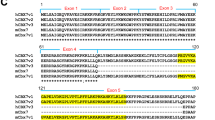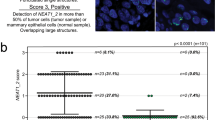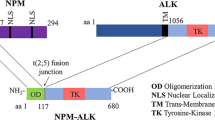Abstract
ErbB-4 is a recently described member of the epidermal growth factor receptor (EGFR) family which together with erbB-3 acts as a receptor for a group of ligands known as the neuregulins (NRGs) or heregulins (HRGs). Unlike the EGFR and erbB-2 relatively little is known about the expression of erbB-4 in human tumours. Using RT–PCR and Southern blotting analysis we have investigated the expression of erbB-4 mRNA in a range of human tumour cell lines and in normal and malignant breast tissue. Using primers which amplified a 658 base pair (bp) region corresponding to part of the cytoplasmic domain of c-erbB-4 we found the receptor was expressed in some but not all breast and ovarian tumour cell lines and also in a glioma cell line. The highest level of erbB-4 expression was found in the ovarian carcinoma OVCAR-3 and the breast carcinoma T-47D. In all cell lines where the `full-length' erbB-4 was detected, a second previously undescribed c-erbB-4 sequence was also found as a 610 bp PCR product. The alternative PCR product was identical in sequence to c-erbB-4 except for a deletion of 48 bp which encodes a consensus phosphatidylinositol 3-kinase (PI3K) binding site. This suggested that the two forms of erbB-4 might interact with different intracellular signalling pathways and therefore influence a wider variety of cellular responses to heregulin than previously thought. Expression of both erbB-4 variants was found in 7/7 normal breast tissues but only in 9/12 breast tumours analysed. In line with the terminology of we have designated the two isoforms of the C-terminal transcripts as CT-a (full-length) and CT-b which lacks the PI3K binding motif. These results identify suitable cell lines for the further investigation of erbB-4 expression and function and suggest that the role of erbB-4 in breast cancer warrants further investigation with larger numbers of normal and malignant breast tissues.
This is a preview of subscription content, access via your institution
Access options
Subscribe to this journal
Receive 50 print issues and online access
$259.00 per year
only $5.18 per issue
Buy this article
- Purchase on Springer Link
- Instant access to full article PDF
Prices may be subject to local taxes which are calculated during checkout
Similar content being viewed by others
Author information
Authors and Affiliations
Rights and permissions
About this article
Cite this article
Sawyer, C., Hiles, I., Page, M. et al. Two erbB-4 transcripts are expressed in normal breast and in most breast cancers. Oncogene 17, 919–924 (1998). https://doi.org/10.1038/sj.onc.1202015
Received:
Revised:
Accepted:
Published:
Issue Date:
DOI: https://doi.org/10.1038/sj.onc.1202015



